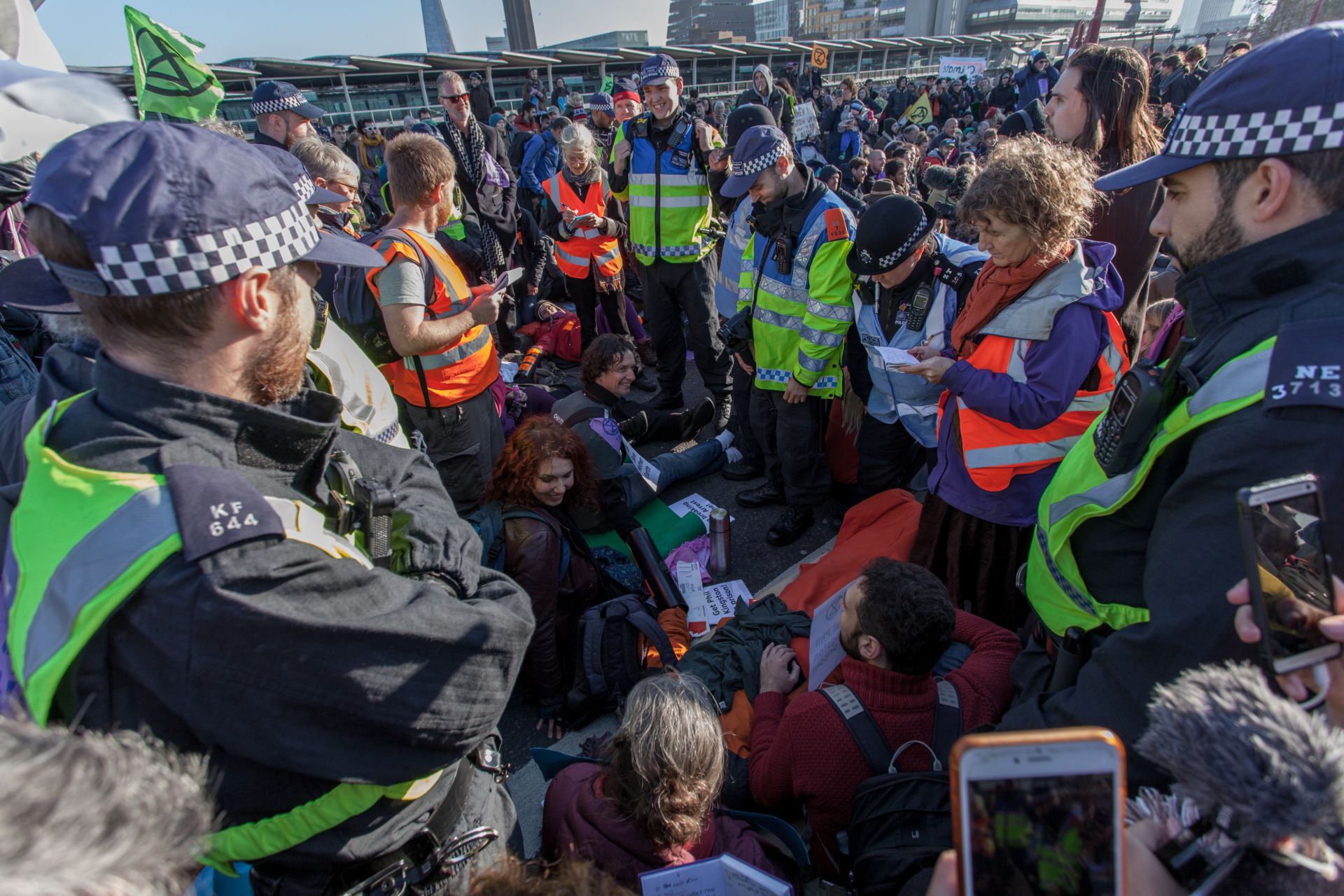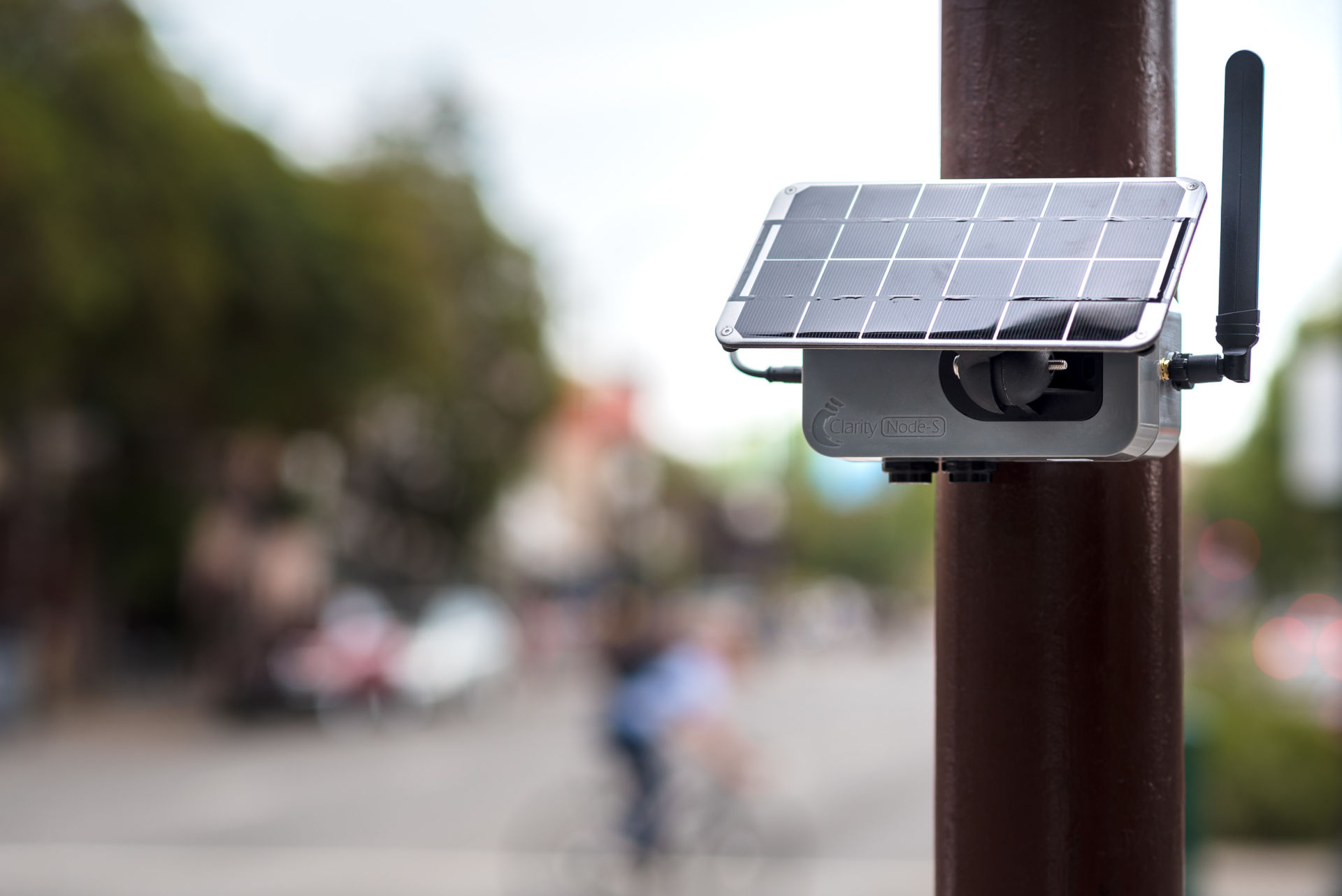On April 15, Extinction Rebellion groups around the world are planning mass civil disobedience to force governments into action over climate and ecological breakdown. In London, thousands of people will block key roads for several days, with the intention of bringing the city to a standstill. The following is an account of my experiences inside XR and how its strategy of disruption is developing…
1. The Bridges
In the London Review of Books maybe twenty years ago, there was an essay – I don’t remember the author or the title – asking why we aren’t in a state of constant terror and outrage over climate change, why the social contract hasn’t gone out the window, why we aren’t breaking the law to force action and target the worst perpetrators. That article lodged somewhere in my unconscious and emerged again at the tail end of last year, when my wife forwarded me a link for an upcoming action by something called Extinction Rebellion. They were planning to block five bridges over the Thames, aiming to shut down central London for the day. They needed bodies, ideally people willing to be arrested.
Here was a group that was upfront not only about imminent climate and ecological collapse, and the breakdown of civilization that will be triggered. They were also honest about the radical disruption that’s going to be necessary to do change anything. For once, a lot was being asked of us as citizens and protestors. Not clicking a petition or joining a Greenpeace campaign, or even using mainstream democratic methods, which haven’t worked, but non-violent direct action aimed at disrupting business as usual before it kills the earth. Extinction Rebellion seemed to combine intense grief over everything the IPCC has (and hasn’t) told us with extraordinary action. This was the group I’d been waiting for, without even knowing it.
I’d been a sporadic protestor and had attended a handful of Greenpeace meetings, but nothing seemed up to the current emergency. My wife too, frustrated by my useless sadness and paralysis over climate change, also now saw a practical outlet, what XR calls a “pathway to action.” Reading that arrest on the bridges would be essentially voluntary – the London Metropolitan Police typically give multiple warnings before carting anyone to the paddy wagon – we decided to bring our two young girls (aged one and three) with us. This will be the fight of their lives – may as well start them early.
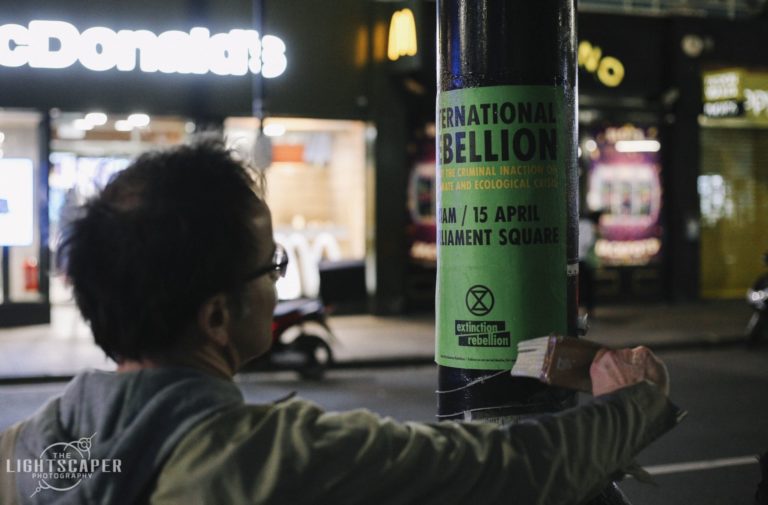
We told our girls we were going to the bridge to protect animals and they were disappointed not to see roaming lions and elephants as we approached Blackfriars. We were nervous, trying to act like tourists for now, sticking to the pavement, snapping pictures of the river, smiling, slipping into Portuguese when police walked past, so as not to attract attention. It turned out to be completely unnecessary and faintly ridiculous. There were far more police at this point than protestors. Taking the bridge looked impossible with these measly numbers. But gradually, a group cohered at a bus stop, pretending to wait for a bus. How could we be moved along or arrested for that? The XR website instructed us to “wait for the signal” to take the bridge, but no signal was forthcoming from anyone.
I could see over on Westminster bridge that double decker buses were already at a standstill at either end. Clearly the roadblock had already begun there. Finally, and with no obvious signal, a small group linked arms and just stepped out onto the road at the next red traffic light. We all quickly followed, a couple hundred of us pouring into the empty road. We immediately sat down, unrolled picnic blankets, got out food and placards. Flags were handed out with the XR sand timer symbol, which will hopefully become as iconic as the CND peace sign. We very quickly made the road ours. The police let it all happen without intervening. The transgression was thrilling.
I’d always thought that a problem with protest is that it tends to make participants feel good – doing wonders for your dopamine levels and possibly for your ego – in a way that’s disconnected from any practical results. On the bridge, I realized that feeling good in a protest is no bad thing. As long as it doesn’t stop you from pushing for real impact, feeling good in the meantime means you’re already creating a microcosm of the kind of world you want to build. Climate and ecological collapse feels so intrinsic to the all-encompassing civilization we inhabit that the whole package sometimes seems impossible to escape. But it turns out the everyday world melts away with surprising ease, like the thinnest layer of ice in the November sunshine. Like it’s been wanting to all this time.
Someone set up a sound system. There was beatboxing and grungy EDM. The occupation quickly became a party. George Monbiot gave a speech, saying we don’t need to choose anymore between saving the planet and the multiple silos of social justice movements, because the target of each fight is the same in every case: inequality, oligarchy, the erosion of democracy.
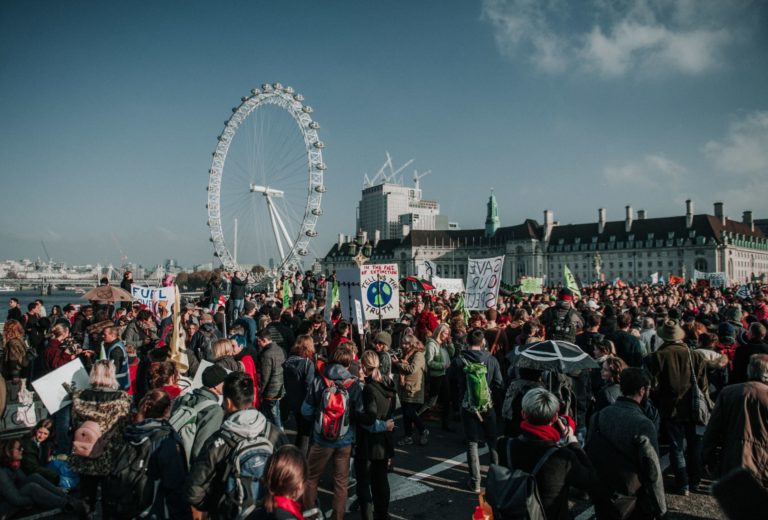
Tweets started to come in: all five bridges were now occupied. Up to 6,000 people in place. And the police were actually facilitating our road blocks by setting up their own at each end of the bridges. (What about ambulances, you may ask. We would have let them through of course, but the police vans made it impossible.)
After a few untroubled hours of occupation, in which our girls wandered happily around, petting dogs, listening to people play guitars, a fresh group of Extinction Rebels arrived on “our” bridge. Their bridge, Lambeth, had been overtaken by police and a bunch of people arrested. So now we had fresh numbers and energy and the party carried on another couple of hours until, with a sense of mission accomplished on Blackfriars, people converged on Westminster Bridge, right outside parliament.
A few dozen of us decided to stay where we were as the police began closing in on a few people lying on the road who’d surreptitiously padlocked their arms together inside sawn-off tubes of plastic piping. The lock-ons were all from Christian Climate Action, many of them seemingly in their 60s or older. Police liaison officers in baby blue jackets crouched down, trying to persuade them to get up, warning them of arrest, but the lock-ons remained impassive, saying almost nothing in reply, not wishing to incriminate themselves or give up any information on their plans or those of their brothers and sisters.
The atmosphere shifted from party to vigil as a strange, slow, complicit choreography began between police and protestors. There was zero animosity between the sides, just an acknowledgement that each was doing its duty and would now proceed according to script. The police formed a ring around this hardcore group. (I later learned this is called a “sterile area” in police parlance, a tactic to isolate the hottest part of a protest.) It was quiet now except for a few ballads sung on repeat by those of us watching from outside the ring. Even Amazing Grace got a run out. A police technical team, wearing baseball caps, arrived with small buzzsaws and politely asked if they could put safety goggles on each protestor and gently did so before cutting them loose from their chains. Some were led willingly to the waiting police vans and a holding cell for up to 24 hours. Others went totally limp and had to be carried away – embodying passive resistance to the max.
Extinction Rebellion blocked five bridges for most of the day, bringing traffic across the capital to a standstill. It was the biggest act of civil disobedience the UK had seen for decades. Eighty-five people were arrested. It got about 10 seconds coverage on the BBC news that night.
2. Holocracy
A couple of weeks after the bridge occupation, a hundred people crammed into a small room at the Quaker Meeting House in Charing Cross for the second meeting of XR’s London Working Groups. A hundred more newbies were in the room next door, being inducted into Extinction Rebellion. XR was growing rapidly. It only launched in May 2018, the brainchild of a few founding members based in Wales and Stroud. Now dozens of local groups were sprouting up around the UK and parallel XR groups were appearing around the world (Extinction Rebellion currently has 331 groups in 49 different countries). A letter from XR to the Guardian calling on the government “to develop a credible plan for rapid total decarbonisation of the economy” was signed by nearly 100 academics, and by Rowan Moore, the former Bishop of Canterbury.
XR’s small core team was actively starting to devolve, to allow the movement to become organic, self-organizing, able to spring up anywhere. Decision making would not be centralized or hierarchical – this is not a classical political organization with diktats being issued from the top. Neither would it be consensus based because nothing would get done. XR instead functions as a holocracy, where anyone can self-start any initiative in the name of XR as long as it broadly agrees with the group’s principles and demands. No approval is required, but you are encouraged to share your ideas with a few people in the group for feedback.
We gathered round designated tables for different working groups: media and messaging, action and logistics, outreach, and regenerative culture (tasked with making sure the rebellion stays emotionally and socially healthy and activists avoid burnout and internal conflicts). On the media table, it’s predictably awkward at first; no one really knows what to do, and we can hardly hear each other over the cacophony of voices in the room. It’s clear we’d need a high tolerance for messiness as Whatsapp and Signal groups were formed and skills established, before we get to the point of planning anything. But everything felt raw, molten, alive.
3. Hope Versus Panic
In the following weeks a debate emerged in the media group about the appropriate level of shock and sadness in XR’s messaging. Does a focus on the severity of the climate and ecological crisis make people feel powerless and resigned? Should we focus instead on positives, examples of change and hope? Greta Thunberg, who started the school strike movement at the age of 15 by sitting alone on the steps of the Swedish parliament, has a choice quote on this issue: “I don’t want your hope,” she says. “I want you to panic. I want you to feel the fear I do. Every day. And I want you to act. I want you to behave like our house is on fire. Because it is.”
Hope can drive complacency – the belief that things may be bad, but we’ll innovate our way out of the crisis, and someone will deal it, because aren’t we such a clever species? Alexandria Ocasio Cortez recently identified that it’s not climate “deniers” who are the problem but climate “delayers” – people who think we still have time, and that existing political and corporate frameworks will reliably produce solutions. Instead of these happy stories, I tend to think what’s needed in order to trigger engagement is radical acknowledgement of just how bad things are and how current systems aren’t built to deal with the crisis. People can know, theoretically, about climate change, without acknowledging its severity. Think mass food shortages, possibly within just a few years, as droughts gets worse, think 200 million climate migrants (an extremely conservative estimate), and the inevitable collapse of our intricately connected civilization, simultaneous with the collapse of the Earth systems that sustain us. When you “know” these things, when you’ve metabolized them, everything else feels like a distraction.
The difficult thing about climate change is that it’s hard to live every day and every minute accepting that it’s actually true. You get distracted by the thin veneer of normality, by civilization’s thrumming and threshing. You can know something is true but can’t always live in that truth. Not so different from some experiences of religious faith. And like religious faith, there’s a sense of awakening and compulsion coursing through XR. I met a woman, a drama teacher, who said she only learned the full extent of the climate crisis a couple of weeks ago, and she’s been in a state of near-panic ever since. She knew about climate change, but thought it was all coming 300 years in the future (we’ve been coached to reflexively believe climate change is all about sea level rise and that this is an incredibly slow process). Now, she told me, there’s nothing else to do but work full time, flat out on trying to slow down what’s coming.

There’s also a culture of grieving at XR too. It’s encouraged. People new to the group often arrive talking about breaking down, crying like they’re never going to stop, when they finally absorb the prognosis for the planet. Mothers joining the XR families group talk about the anxiety they feel for their children, and the uncertainty over how much they should be telling them about what’s coming. For all these people, XR’s strategy of mass disruption – let’s call it extraordinary action – finally feels like a useful outlet.
4. BBC and a War Footing
Extinction Rebellion has three core demands. The first is that the government and the media must “tell the truth” about the urgency and severity of the climate and ecological crisis. The phrasing is pointed. It’s a moral issue more than a political one.
The BBC, a cherished public institution that we fund through our TV licenses, played a crucial role in putting the UK on a war footing and maintaining morale in the Second World War. A similar intensity of focus is needed now on climate change, where everything else – even Brexit – is in comparison a sideshow. That’s why Extinction Rebellion chose to target the BBC for its next major action, with the demand that they declare a climate emergency. A few days earlier, XR had succeeded in getting the London Assembly to declare a climate emergency, and a spate of towns and cities across the UK were doing the same, thanks to pressure from local XR groups. In lieu of any action from central government, a tidal wave of local emergencies will have to do for now.
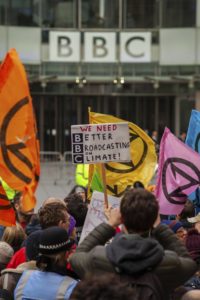


About 300 people gathered outside the BBC, which the police had already barricaded before we got there. We banged drums and pots and pans, sang songs, called on the BBC director-general Tony Hall to come down and meet us. It wasn’t a big protest like the bridges, but we had the numbers to block every entrance and put the building on lockdown. Linking arms with others, we were jostled and pushed by police trying to break the chain. Hundreds of audience members for a Christmas classical music concert were stuck in line outside the building; some of them furious with us for ruining Christmas. Eventually a few rebels were invited inside to be interviewed on the Jeremy Vine radio show, where he turned out to be surprisingly sympathetic to XR given that he wouldn’t be able to leave the building any time soon.
There is more potential support from within. The BBC nature broadcaster David Attenborough, probably the most trusted man in the UK but typically circumspect about the mortal threat to nature, was now raising the alarm. Speaking at the UN climate change summit in Poland, he said: “If we don’t take action, the collapse of our civilizations and the extinction of much of the natural world is on the horizon.”
It feels like you don’t have to scratch very deeply to find that nobody really believes in the system anymore, in the basic postwar contract: put your faith and all your toil into the project of civilization and it will repay you, benefit others, and improve the world.
5. Citizens’ Assembly
Extinction Rebellion’s second demand is for the UK government to achieve net zero carbon emissions by 2025. That’s a stretch goal of course, meant to light a fire under our collective ass given that the UK’s current target is a measly 57 percent reduction on 1990 levels by 2030. XR deliberately avoids recommending specific solutions to get us to net zero carbon in six years. It definitely has ideas about radically changing the economy to make it possible, but the actual formulation of policy must be a democratic process. That’s where XR’s third demand comes in: create a Citizens Assembly to instruct the government on climate policy.
The exact role of this Citizens Assembly was a major subject of discussion at the XR National Strategy Meeting in January, held in a former factory building in Finsbury Park. There had been a few more actions, a funeral march on Downing Street among them, and a lot more media coverage. Momentum was building, and XR needed to elaborate on its strategy accordingly.
It’s only because of our limited experience with direct democracy in the UK that Citizens Assemblies are treated like some exotic curiosity. One was used in Ireland in 2016 to consider abortion, fixed term parliaments, referendums, and climate change. Iceland launched one to create a new constitution, although parliament voted it down; the Netherlands and British Columbia have used them. Citizens Assemblies are set up through sortition, a process similar to jury selection, with a key difference: people are randomly selected but proportionally from every demographic group, ensuring a representative spread of voices. This is a form of democracy without the corrupting forces of elections, money, or prolonged periods in power. Whereas elected politicians are in thrall to special interest groups and terrified of making decisions they think will be unpopular, even ones that our best science points to as logical, Citizens Assemblies are built to make policy on the merits of what’s presented to them by panels of experts.
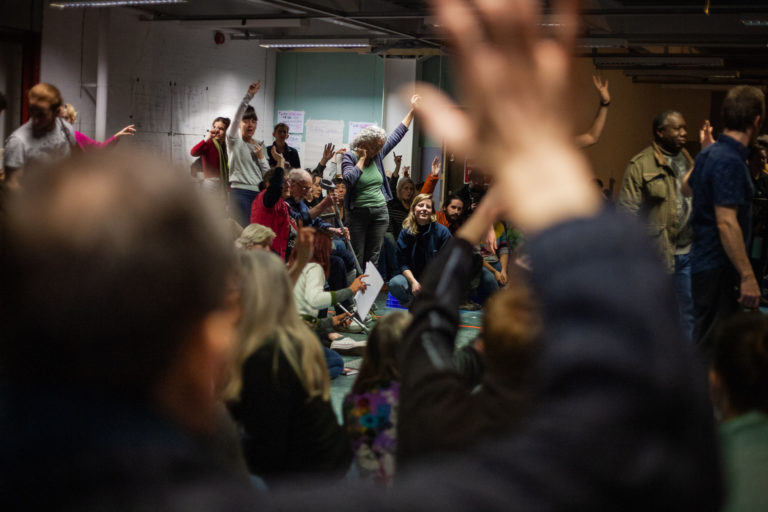
The question came up at the meeting: should “our” Citizens Assembly actually replace the entire government or should it simply instruct it on climate policy? How can you hope to decarbonize the economy and protect our ecology without removing the model of endless economic growth that’s underwriting the whole unfolding disaster? It won’t be a matter of smart policy but of fundamentally restructuring the economy, and those in power aren’t just going to let us do that. Few people in XR would deny the truth of this, but the view prevailed that there’s no time to work systemically on such a massive goal like reinventing capitalism and reengineering our democracy from the ground up. XR is a brand-new mass mobilization movement, not a deeply embedded policy or community organizing institution. The call for revolution – if toppling the government constitutes a revolution – would alienate people who aren’t already on board with XR. And this is going to be a numbers game: because we need as many people as possible turning out on the streets when the time comes. Which is soon.
6. Teach the Truth
On a creepily warm day in February, about 200 of us, including a lot of children, gathered outside the Department for Education to demand that climate change is made an integral part of the curriculum. Tim Rose, a teacher who organized the event, calculated that schoolchildren might only hear climate change talked about in only 10 out of 10,000 lessons over their school career. Academics, teachers, and children all took to the stage and we shouted up at the building: “Teach the truth!” until we were hoarse. The event culminated with Rose daubing “Teach the truth” in spray chalk on the building. He then sat down and dozens of kids sat around him in solidarity. He was fully prepared to be arrested but the police did not step in, apparently not wanting to make a scene in front of children. The police are becoming suspiciously tolerant of XR actions. Maybe they have a strategy to let the air out of the valve. Maybe things have to get more spiky. Tim quit his job shortly afterwards to focus full time on the climate crisis – because what else is there to do?
Editor’s Picks — Related Articles:

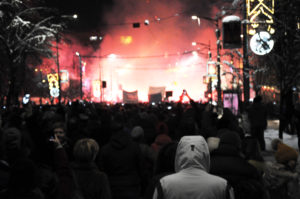
“Enough Bloody Shirts: The 1 in 5 Million March”
7. International Rebellion Week
XR’s strategy is built largely on the research of Co-founder Roger Hallam, a wiry, intense, and until now a disillusioned lifelong activist. Before setting up XR, he was an organic farmer in Wales but had to stop, he says, because climate change made his work too precarious. He couldn’t make a living wage any longer. So he came to London to study for his PhD at King’s college. His topic: the history of non-violent rebellions. After years of conventional protest that hadn’t worked, he wanted to systematically study what had. Meanwhile he went on hunger strike to force King’s College to divest from fossil fuels, which they eventually did, but only after expelling and inviting him back twice.
Hallam’s spiel is that he’s studied enough rebellions now to decipher the necessary ingredients, and the patterns they tend to follow. Key is shutting down the capital city. If somewhere between 10,000 and 30,000 people turn up on the streets and bring the city to a halt, media attention will trigger a tipping point whereby more people will keep showing up to replenish the numbers. The action must remain non-violent if it’s to win sympathy, and it should be unpredictable and “lary.” “It’s fun to break the law,” Hallam says. “I’m sorry, but it is.” At this point, the authorities will be confronted with a dilemma: either let the shutdown continue, which risks further economic losses for the capital; or begin repressing it through arrests, which risks the “backfiring” effect, whereby the arrestees are constantly replaced by new people showing up in solidarity. Or they can open negotiations with representatives of the protestors. So in every scenario here – as long as the “dilemma” has been forced upon the government with sufficient intensity and perseverance – they’re in a losing position. Simple.
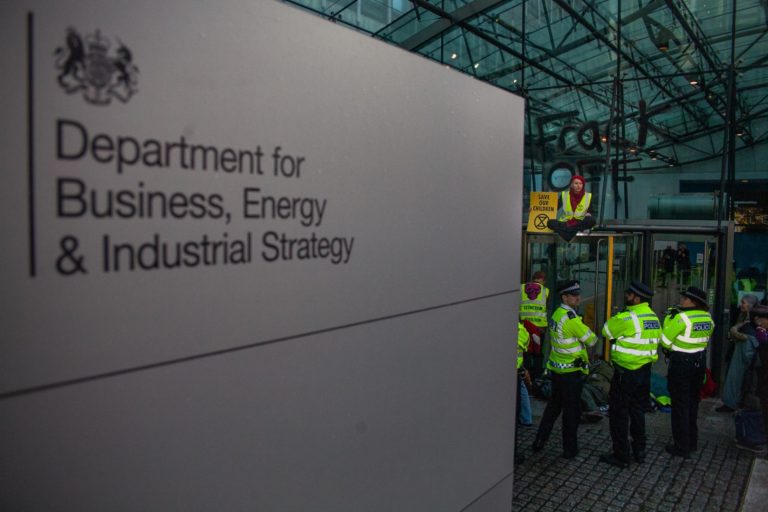
This is the plan for XR’s International Rebellion Week, starting on April 15 in London and around the world. Groups in other countries develop their own unique demands and strategies which reflect their context. In London, people will gather outside parliament and if, as seems inevitable, the government refuses to negotiate, they’ll set up a campsite there and at other key traffic choke points throughout the city. The goal is to create a Glastonbury atmosphere in the city, and bring business as usual to a grinding halt. It will be like the high point of the Occupy movement, except bigger and with specific demands. If the government eventually agrees to talk, negotiating teams are ready. It should not be beyond the realms of possibility that the government agrees to set up an emergency Citizens’ Assembly on climate change.
8. The Children’s March
Something else Hallam espouses is the non-linear effects of protest, of things spinning out of control in a way that may seem bad but turns out to be positive. He was talking before a screening of the documentary “The Children’s March” in an empty hall in an old swimming baths in Hackney Wick. It’s about Birmingham, Alabama in 1963, when thousands of school children walked out of classrooms to get themselves arrested, overwhelming the jails and forcing negotiations that led to de-segregation. The point, said Hallam, is not to draw moral comparisons between our movement and theirs, but to make strategic comparisons that might be relevant. Like the fact that Birmingham was the most segregated city in the American south, so it seemed the least likely place for a successful African-American uprising. But before every single instance of significant change, Hallam noted, people always say: “It can’t happen here. Our circumstances are uniquely difficult.” And then it happens anyway.
Another thing that “always happens” is that the original leaders of a movement discourage what turns out to be the decisive action, saying things are going too far, the timing isn’t right, the risk is too great. Martin Luther King himself did it in Alabama. Then it happened anyway, and it worked.
The participants interviewed in the documentary seem incredibly jovial as they look back on what they did. Even though they were met with violence on the day and systemic violence throughout their lives, even though being thrown in jail was terrifying, they now make jokes about getting pinged around by fire hoses and stress the fun of it all. It’s a kind of anti-trauma. They seem to be marked by the joy of their transgression in the Children’s March and the victory they won. Hallam interjected again that non-violent direct action is “messy, people get injured, upset, but at the same time people have lots of fun. It’s a strange combination.”
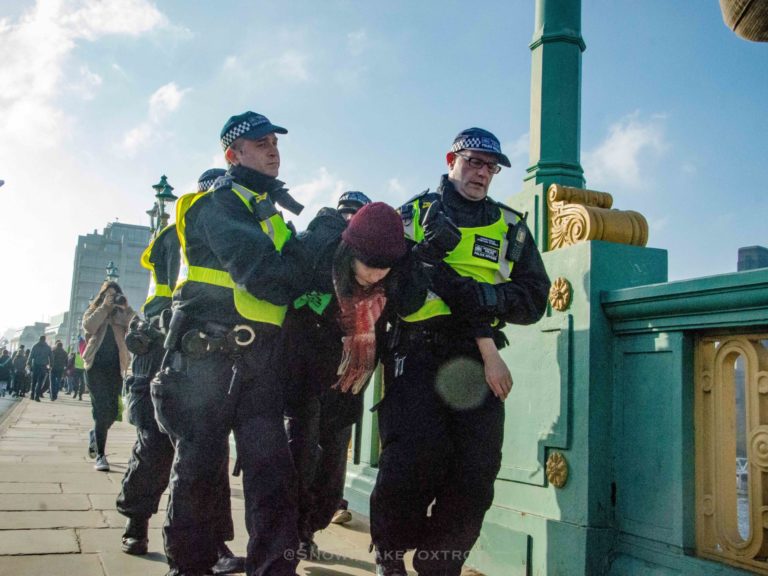
Hallam can really rub people the wrong way with his slightly glib, though always well researched rhetoric. At this point my friend, who’d been looking physically uncomfortable throughout, whispered that he was going to leave. It was obvious why. There are clearly huge problems with comparing civil rights activism from the 1960s with 21st century, first world climate change activism. The vast majority of the latter haven’t suffered at all yet through climate change, while the people in the documentary had suffered collectively and historically from 70 years of segregation and violence and hundreds of years of slavery. Their compulsion to transgress, and the risks involved for them are a universe apart from anything we face yet. But climate collapse will, in the not too distant future, have a much higher death toll and create even more suffering than slavery and its aftermath. Everything has to be projected forwards in time – though not by very long – and outwards, to other parts of the world, other people, and other species that will suffer first and worst.
And you cannot cling onto climate change like people in Alabama clung to the lunch counters as they were being beaten and dragged away by angry racist white people. You can’t lay down in a flood or a hurricane to protest its cause. What you can do is superglue your hands to the door of the fancy London hotel hosting “International Petroleum Week” and get yourself arrested (which XR did). You acknowledge that while this particular conference is not doing you personal and immediate harm, the chain of cause and effect (and reaction) is not always linear and apparent, though as Hallam noted, it’s becoming more so everywhere. It was 70 degrees in London this February.
Hallam’s model of history as a guide only gets us so far. But if the climate movement achieves a tipping point where non-linear effects start unfolding, who knows. Exactly because our situation is utterly unprecedented, exactly because everyone will be affected, and maybe exactly because we’re in this strange position of teetering on the brink of collapse but still being pretty comfortable while teetering, something significant could happen fast, blowing away all the models of what we think has to be in place before massive change can occur. One thing is obvious: April 15 will only be the beginning.
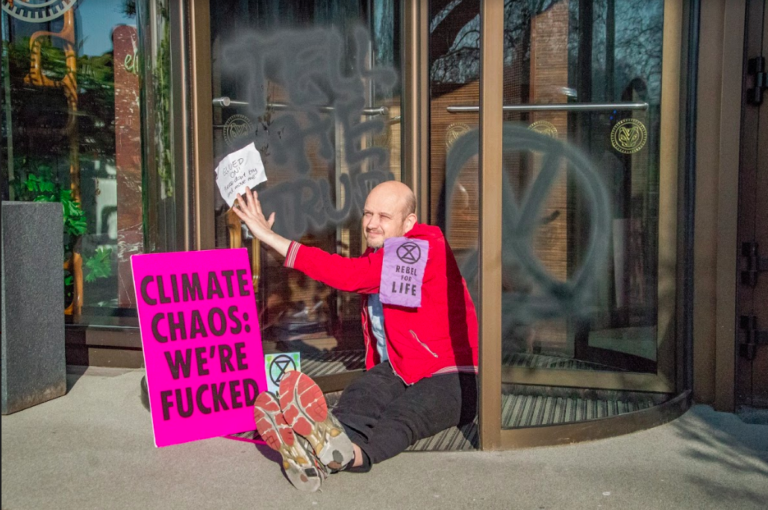
The last two Youth Strike 4 Climate gatherings in central London have been huge, wild, unpredictable and incredibly inspiring. Thousands of teenagers roamed wherever they pleased, blocking roads and bridges. There was no clear plan, and it worked. Central London was shut down. The police had no idea where to go or what to do. The youth strikers are angry, lucid, and have already lost the future our civilization promised them. They will probably be the non-linear effect the climate movement desperately needs.


